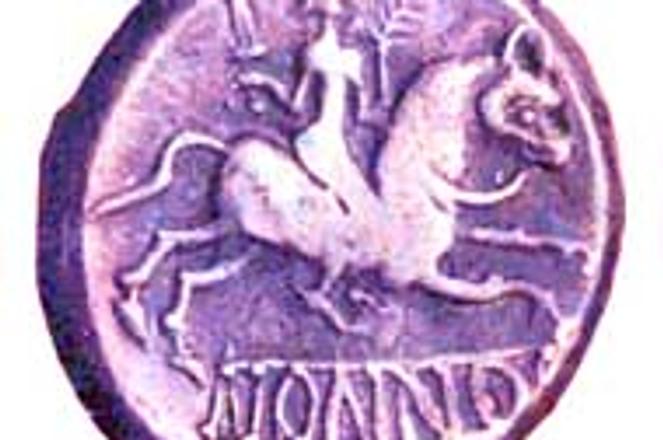SLOVAK-Breton group Keltieg revives traditional Celtic music.photo: Courtesy of Keltieg
THE WARLIKE Celts are the oldest known nation in central Europe. From their original homeland, bordered by the Rhine river, the Alps and the Czech Šumava region, they spread to Ireland in the west, Ukraine and Poland in the east, and Spain and Italy in the south. During the first wave of expansion, in the 5th century BC, they settled in the Carpathian basin, which forms part of modern-day Slovakia.
These 'eastern Celts', moving from today's Czech Republic, concentrated around Slovakia's current capital, Bratislava. There they forged silver coins emblazoned with the portraits of their rulers, which are among the most beautiful works of the historic Celtic world, says archaeologist Karol Pieta.
"Even though we cannot directly link modern Slovakia with the Celtic world from two millenniums ago, because there were other nations [Germans, later Slavs] living on this territory in between, the developed Celtic culture is part of our historical heritage, a message we have to protect and continue," says Pieta.
Until recently, those interested in learning about local Celtic history had to dig out the facts from museums, while those interested in modern Celtic culture had to travel abroad.
But that is no longer the case. In 1998, local Celtic enthusiasts formed the Keltieg band, which performs traditional Celtic music in Slovakia. Two years later they started to organise celebrations of major Celtic holidays, reviving the ancient nation's culture for a larger audience. On April 30 they will celebrate the most significant of four annual Celtic holidays - Beltine, the Holiday of Fires - at Červený kameň castle near Bratislava.
"We felt the need to present this significant culture and make people aware of it," says Roman Kozák from Keltieg, which is now both a band and a civic association.
Such festivals, organised four times a year, awaken a long-dormant Celtic spirit in Slovakia, hosting international musicians, dancers, artists and archaeologists. Each event celebrates one of the four important holidays of the Celtic year with a particular focus.
"Celts used to have four months, similar to our four seasons. The new year according to their calendar started at the end of October [today All Saints' Day], known as the Samhain holiday. Then they celebrated spring on February 1, the Imbolc holiday. Beltine, lasting from the last day in April to May 1, was the Day of Fire, assuring enough sunlight to achieve a large crop. The last holiday, Lughnasadh, was a harvest celebration," says Kozák.
While the festival's celebration of Imbolc is devoted to musicians, Samhain to children and Lughnasadh to craftsmen, the upcoming celebration of the largest Beltine holiday incorporates all of these elements.
The gates of Červený kameň castle will open at 17:00 on April 30. Two symbolic bonfires will be lit, between which Celts used to drive cattle in order to protect them from disease. Craftsmen will display Celtic products such as coins, honey candles and metal works. In a temporarily erected Celtic village a group of warriors will perform old Celtic fighting techniques. Celtic historical artefacts will be exhibited and Celtic specialities - a beer goulash and a honey alcohol drink - will be served to guests.
During a festival spanning the entire night until noon the next day, eight musical and four dancing groups will provide the entertainment.
"Fernhill, from Wales, is the festival's headliner. It's one of the few bands that play Celtic music. Even though the band isn't very popular outside of Wales, singer Julie Murphy is a jewel among British female folk singers. She played with Peter Gabriel and also the former singer from Led Zeppelin, Robert Plant," says Kozák, whose seven-member Keltieg band with a Breton (France) singer will perform traditional Celtic music influenced by Slovak folklore.
Celtic music is characterised by lively rhythms from whistles, pipes, violins and drums. However, nobody knows how it was played 2,000 years ago, Kozák says. "Today, Celtic music is considered everything traditional that comes from Celtic ancestors from Ireland, Scotland, Wales, Galicia and Bretonia."
While 'Celt-mania' swept the world some 30 years ago, it has come to Slovakia only recently.
"There wasn't any interest in that culture, because people here were more focused on their Slavic culture. I'm not saying that now all Slovaks are Celts, since we are equally as Celtic as other Slavic nations. But Celts were the first nation who legitimised this territory. Moreover, they left many significant traces behind which shouldn't go unnoticed," says Kozák.
Archaeologist Pieta agrees that the promotion of Celtic culture should be improved around the country, but at the same time warns of enthusiastic extremes.
"Celt-mania is 'in', people around the world are going crazy about it. While it's good that there's somebody promoting it, we also need to restrain the enthusiasts who seem to be more Celtic than Slovak.
"However, it's not just Celtic culture that lacks historical consciousness. It's also Slovak culture. We don't yet have the right attitude to historical memorials. We either destroy them with concrete or turn them into Disneyland."
What: Beltine - Celtic holiday festival.
Where: Červený Kameň castle, 40 kilometers north of Bratislava, direction Pezinok - Častá.
When: April 30 at 17:00 until May 1 noon.
Admission: Sk220.
Tel: 033/6495-316 (castle), 02/5441-8090 (Keltieg).
For more information on the festival go to http://mojweb.sk/beltine

